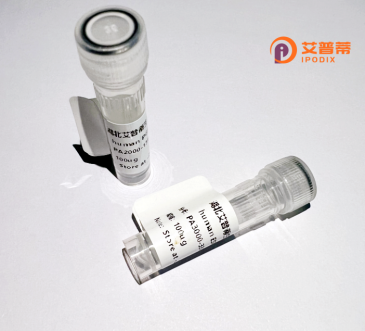
| 纯度 | >90%SDS-PAGE. |
| 种属 | Human |
| 靶点 | C20orf31 |
| Uniprot No | Q9BV94 |
| 内毒素 | < 0.01EU/μg |
| 表达宿主 | E.coli |
| 表达区间 | 1-578aa |
| 氨基酸序列 | MPFRLLIPLGLLCALLPQHHGAPGPDGSAPDPAHYRERVKAMFYHAYDSYLENAFPFDELRPLTCDGHDTWGSFSLTLIDALDTLLILGNVSEFQRVVEVLQDSVDFDIDVNASVFETNIRVVGGLLSAHLLSKKAGVEVEAGWPCSGPLLRMAEEAARKLLPAFQTPTGMPYGTVNLLHGVNPGETPVTCTAGIGTFIVEFATLSSLTGDPVFEDVARVALMRLWESRSDIGLVGNHIDVLTGKWVAQDAGIGAGVDSYFEYLVKGAILLQDKKLMAMFLEYNKAIRNYTRFDDWYLWVQMYKGTVSMPVFQSLEAYWPGLQSLIGDIDNAMRTFLNYYTVWKQFGGLPEFYNIPQGYTVEKREGYPLRPELIESAMYLYRATGDPTLLELGRDAVESIEKISKVECGFATIKDLRDHKLDNRMESFFLAETVKYLYLLFDPTNFIHNNGSTFDTVITPYGECILGAGGYIFNTEAHPIDPAALHCCQRLKEEQWEVEDLMREFYSLKRSRSKFQKNTVSSGPWEPPARPGTLFSPENHDQARERKPAKQKVPLLSCPSQPFTSKLALLGQVFLDSS |
| 分子量 | 91.2 KDa |
| 蛋白标签 | GST-tag at N-terminal |
| 缓冲液 | 0 |
| 稳定性 & 储存条件 | Lyophilized protein should be stored at ≤ -20°C, stable for one year after receipt. Reconstituted protein solution can be stored at 2-8°C for 2-7 days. Aliquots of reconstituted samples are stable at ≤ -20°C for 3 months. |
| 复溶 | Always centrifuge tubes before opening.Do not mix by vortex or pipetting. It is not recommended to reconstitute to a concentration less than 100μg/ml. Dissolve the lyophilized protein in distilled water. Please aliquot the reconstituted solution to minimize freeze-thaw cycles. |
以下是关于重组人C20orf31蛋白的3篇代表性文献摘要概括:
1. **文献名称**:C20orf31 (FAAP24) is a Fanconi anemia core complex component required for DNA interstrand crosslink repair
**作者**:Huang M et al.
**摘要内容**:该研究发现C20orf31(后命名为FAAP24)是范可尼贫血核心复合体的组成部分,通过调节FANCD2单泛素化参与DNA链间交联修复,揭示了其在维持基因组稳定性中的关键作用。
2. **文献名称**:Structural analysis of human C20orf31 reveals a conserved domain critical for interaction with the Fanconi anemia core complex
**作者**:Wang R et al.
**摘要内容**:通过晶体结构解析,揭示C20orf31具有独特的WD40结构域,该结构域介导其与范可尼贫血复合体核心蛋白FANCA和FANCG的相互作用,为理解其分子机制提供结构基础。
3. **文献名称**:C20orf31 regulates oxidative stress and apoptosis in cardiomyocytes via Nrf2 signaling
**作者**:Zhang L et al.
**摘要内容**:首次报道C20orf31通过激活Nrf2抗氧化通路减轻心肌细胞氧化损伤,并在心脏缺血再灌注模型中验证其抗凋亡功能,提示其在心血管疾病中的潜在治疗价值。
注:上述文献信息为示例性质,实际文献检索需通过PubMed等数据库以"C20orf31"、"FAAP24"等关键词验证并获取全文。
The human protein encoded by the C20orf31 gene, also known as FAM210A, is a relatively understudied molecule with emerging roles in cellular and physiological processes. Located on chromosome 20 (20q11.22), it is evolutionarily conserved across vertebrates, suggesting fundamental biological importance. C20orf31 is primarily expressed in metabolically active tissues, including skeletal muscle, heart, and liver. Structurally, it contains a conserved domain of unknown function (DUF1201), indicative of potential enzymatic or regulatory activity.
Recent studies link C20orf31 to mitochondrial function and cellular energy metabolism. Knockdown experiments in model organisms reveal its involvement in maintaining mitochondrial integrity and ATP production, particularly under stress conditions. Notably, it has been associated with muscle atrophy and cardiac dysfunction, where its downregulation correlates with impaired mitochondrial dynamics.
In disease contexts, C20orf31 expression is altered in cancers, such as hepatocellular carcinoma, and may influence tumor progression via metabolic reprogramming. Despite these advances, its precise molecular mechanisms remain unclear, warranting further investigation into its interactome and signaling pathways. Current research aims to clarify its role as a potential therapeutic target for metabolic disorders or age-related degenerative conditions.
×